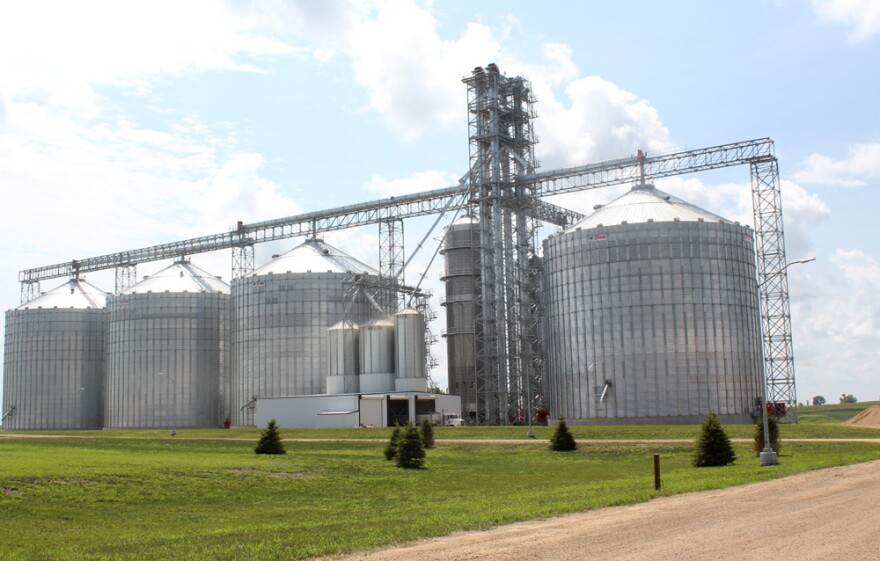Across the rural Midwest, landscapes are dotted with tall, cylindrical storage containers for grain. Some belong to commercial grain elevators, but increasingly farmers want to market their grain throughout the year so they install their own storage bins right on the farm. Maintaining the quality of that grain requires vigilance—and can present safety concerns. In particular, the risk of entrapment when a person enters a bin to check on the grain.
In 2011, there were four grain bin entrapments each in Iowa and North Carolina and two each in Illinois, Nebraska, South Dakota, North Dakota and Texas. These accidents are not always fatal—an Iowa man survived one earlier this summer—but they often are. On-farm bin accidents used to be more common than ones at commercial sites, but that’s no longer always the case.
Story County, Iowa, farmer Kevin Larson started working with his dad about 40 years ago. Back then, Larson said, everyone stored corn, still on the cob, in their own cribs.
“As combining—harvesting with a combine to get just the grain—materialized, some people just took it straight to town as grain,” Larson said, “instead of storing it on the farm.”
But Larson never got in that habit and has always stored his own grain. Now, many other farmers are seeing that with the right tools, on-farm storage can make sense.
Greg Hellman, a sales rep with grain-bin maker Sukup Manufacturing, said an increasing number of farmers now can store hundreds of thousands of bushels of grain, as Larson can.
“It’s just exploded in the last five, 10 years,” Hellman said, “where a lot of these on-farm sites have become like small elevators.”
Wherever the grain is stored, the quality must be maintained or the value plummets. And that’s where the dangerous prospect of entering a bin can arise. Larson checks his bins regularly.
“I feel I have enough experience that I can monitor pretty closely by sight,” he said, adding that as long as grain is not being unloaded, a man can enter a bin and only sink in to about his knees. Inside, Larson looks for any sign that a crust has formed on top.
“If certain conditions occur during storage, it's possible that some moisture will move from the bottom parts of the grain up to the top,” said Iowa State University agricultural engineering professor Carl Bern, “and then condense near the top level of the grain and then mold and form a hard layer. In other words, a crust.”
When grain is unloading, it flows out the bottom of the bin creating an inverted cone inside. If there’s a crust on top, a gap between that crust and the flowing grain is not visible. When grain stops coming out, a farmer may go in to see what’s wrong. It’s called walking the grain. That’s when disaster can strike, because what’s in the bin is not the stable grain mass Larson described.
People get stuck when they punch through the crust, fall into the empty space below, and then get buried as grain falls in all around them.
Scott Haugan wants to stop that from ever happening.
“We’ve been to the moon,” said the Marshalltown, Iowa, businessman, “we can do a better job taking care of grain.”
Haugan’s company, HOWGAN SCC, provides monitoring technology that helps prevent crust from forming.
“You think about the technology we have in hybrid (crops): disease resistant, drought resistant, Round-up resistant,” he said. “Then you think about the technology that producers have today, the inside of a combine looks like the cockpit on an F-17 fighter.”
Technology in the bin is the next logical step, Haugan said. His high-tech systems are on bins throughout the Midwest. A constant data stream from inside the bin feeds the temperature and moisture conditions to software that can trigger alerts or turn fans on as necessary.
At a Mid-Iowa Cooperative elevator in Tama County, Iowa, a control room has monitors that show the conditions in each bin. But a manager can view the data from a remote office or smartphone, too, because it’s all sent over the Internet. HOWGAN technology also constantly monitors energy consumption and Haugan said his company’s equipment can help elevators save on utility bills, too.
Agreement is widespread that the best way to prevent grain bin entrapment is to keep people out of bins. And Iowa State’s Bern agrees with Haugan that the way to do that is to stop the problem-causing crust from ever forming. That’s the engineering puzzle industry and academia continue to pursue.
Meanwhile, Hellman, from the bin maker Sukup, said his company’s Grain Buster is a low-tech device controlled from outside the bin. When the external crank is turned, a chain-covered pipe whips around inside the grain to break up the crust. Hellman said in-bin monitors, from vendors like HOWGAN, are gaining popularity, too.
“Fifteen, 20 years ago those types of temperature cables or monitoring systems were pretty non-existent on farms,” Hellman said, “and now they’re becoming much more prevalent.”
Larson said his tech-free method and cautious approach continue to serve him well.
“We’ve done it long enough that we know the symptoms, what to look for and keep an eye on as needed,” he said.
Larson said no one on his farm enters a bin that’s unloading and he can’t imagine a future when walking the grain is never necessary. Some commercial elevators already have adopted no-entry policies. That prevents entrapments—and also makes those elevators ever more dependent on emerging technologies.




